
send e-mail to A Voyage To Arcturus (note: Spam Arrest is on, so a one-time-only confirmation will be requested)


[ 20060627 ]
The Observant Astronomer, who has me wishing, not for the first time, that I could read Hebrew.
Jay Manifold [7:01 PM]
Heart of America Star Party Pictures
As promised. Click on the images for full-size (640 × 480) versions.

The main entrance to the ASKC's Dark-Sky Site.
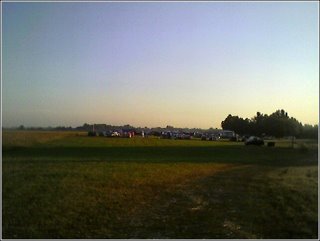
38°13'14" N, 94°33'38" W; looking north at 6:30 AM CDT Sat 24 Jun.

Like waking up inside a Grant Wood painting ... looking south from the same vantage point.

8" f/15 open-frame refractor -- amazing instrument.

The loyal kitchen crew of the Carbon Star Café. Best food I've ever had at a star party!
Jay Manifold [6:47 PM]
[ 20060626 ]
Heart of America Star Party Report
(Event referenced here and here.)
I arrived Friday evening, just at sunset (8:40 PM CDT). Quickly set up my 'scopes and began a tour of the field. At least a hundred attendees were present, bringing nearly that many instruments, ranging up to at least twenty inches in aperture.
They are amateur astronomers from Indiana, Illinois, Kansas, Missouri, and Oklahoma. One man demonstrates a CCD imager on a 4" refractor, which he has used to punch down to magnitude +17, successfully imaging KBOs; I later calculate that this would be adequate to capture a meteoroid only 10 meters in diameter as far away as the Moon -- and as dark as asphalt.
Mercury was in "first quarter" phase, near greatest eastern elongation, low in the west, Saturn and Mars a pair of cat's eyes just above it. Jupiter rules the night, moving slowly eastward through Libra, forty degrees above the southern horizon as twilight ends.
Soft voices of frogs and insects, a dog barking in the distance to the southeast, whir of telescope motors, faint conversation, smells of insect repellant and midwestern hayfield all around.
Another attendee has a unique (to put it mildly) 8" f/15 open-frame refractor pointed at Jupiter -- spectacular detail in North and South Equatorial Belts, and the Galilean moons so big and bright they almost seemed to show disks. Saturn in twilight, Rayleigh scattering in Earth's atmosphere acting as a perfect blue filter -- woodgrain of cloud bands, glorious rings, Cassini and Encke divisions clearly visible, Titan and one or two fainter moons (Tethys, Rhea, Dione?) in retinue.
Dozens of lightning bugs flashing in the trees to the southeast, with Antares and the rest of Scorpius glimmering just above. Arcturus high in the south, nearly at the zenith -- twilight still visible in the northwest at 10 PM -- a sudden, swift meteor flashes through the Summer Triangle from south to north between Aquila and Cygnus.
Did the young Robert Heinlein have nights like this? He was a child in Butler, a fifteen-minute drive away, nearly a century ago.
Leo facing downward toward the horizon in the west. Summer Milky Way rising in the east, stretching from Deneb to Altair and beyond. The Big Dipper almost due overhead, its handle pointing across the zenith to Arcturus.
The fireflies are synchronizing, great rippling patterns of discharge sweeping along the line of trees.
"W" of Cassiopeia just above the northern horizon. M13 naked-eye with averted vision ...
Later: the entire tail of Scorpius is visible above the southern horizon (we are at latitude +38°13'). The "teapot" of Sagittarius is rising in the southeast. At least 120° of the Milky Way is now visible, from north of Cygnus all the way down through the Scutum star cloud, nearly halfway to the galactic center.
Optional reading here.
At 11:16 PM, a magnitude -7 Iridium flare occurs in northern Virgo, and gets a big round of applause.
Much later, in the deep night, with Jupiter setting in the southwest, the Summer Triangle high overhead, and the Milky Way bisecting the sky along the meridian, a tremendous fireball, as bright as the Iridium flare, slashes through the eastern sky from Pegasus to Pisces, piercing the thin, patchy veil of cloud that has sent most of the attendees to bed.
Saturday morning is like waking up inside a Grant Wood painting.
Gently rolling hills of a freshly-mown hayfield extending half a mile to the Marais des Cygnes river, lined with trees. Flawless blue sky, the Sun just above the north-northeastern horizon, and a gentle southerly breeze ... more optional reading here.
This part of western Missouri has become an archetypal savanna. As the high-intensity agriculture and coal mining of an earlier era recedes, land use shifts and patches of forest appear, not only along riverbanks or as windbreaks between properties, but isolated and in small clumps in what were open fields a generation ago. The topography is relatively level, but not monotonously so, with variations in elevation of a few tens of feet, especially near rivers. The land is densely green, except where it has been planted in wheat (which has just been harvested). Corn already stands head-high, and grasses are waist-deep where they have not been mowed.
At four in the afternoon, I see, for the first time in over three decades of frequently-interrupted residence in Missouri, the state bird. One alights on a power line, then swoops down to the grass only about thirty feet from me to seize an insect. It has a melodious but faint song.
An hour later, the clouds that have been gathering since late morning open up and begin unloading at least an inch of rain. I have already packed everything away. I stay for dinner and leave around 6:30, apprehensive about the "impassable during high water" sign I noticed on the way in on Bates County road V, but fortunately it turns out it would take a lot more rain than that to make the Marais des Cygnes overflow its banks. Later on, it cleared off and they got another night of observing, but I didn't feel like setting up in rice-paddy conditions.
Next: pictures.
Jay Manifold [7:30 PM]
[ 20060616 ]
“As he awoke one morning from uneasy dreams --”
-- he found himself transformed into a gigantic ... petri dish.
UPDATE: The latest scientific findings, however, indicate that filth hath its virtues.
UPDATE II: In which case, these guys should live forever (language warning; hat tip: Marcus).
UPDATE III: Previously unknown reader (the best kind) "Ralph" asks: "Are these micro-organisms dangerous or harmless?"
Definitely not harmless. Quoting from the article: "... the Botswana scientists found species of Bacillus, Enterobacter, Escherichia, Klebsiella, Pseudomonas, Serratia, Staphylococcus, Shigella, and Xanthomonas, as well as other coliforms." Googling the various critters is left as an exercise for the reader, not recommended for mealtimes.
He also asks: "If you examined human skin, hair, fingernails, etc - would you find the same thing?" I hope not. Having said that, readers with knowledge of our, uh, dermaflora (if that's a word) are encouraged to submit the scariest legitimate info they can find. Use the link at the top of this page. First-time e-mailers will have to batter their way through Spam Arrest.
UPDATE IV: While we're on the subject of gross stuff, you may wish to reread an old post, Why We Don't See A Lot Of Traditional Icelandic Restaurants.
Jay Manifold [12:29 PM]
[ 20060609 ]
Kiloton-Range Impact in Norway?
That's the implication of Record meteorite hit Norway [sic], an article brought to my attention by Rob Robinson of the ASKC.
Jay Manifold [5:23 PM]
[ 20060606 ]
-- both brought to my attention by Michael Lee, last heard from warning of the hazards of amateur astronomy, these news items:
- Meteor clue to end of Middle East civilisations (not just in Mesopotamia)
- Native Americans recorded supernova explosion (and it's not the one in 1054)
Jay Manifold [8:00 AM]
[ 20060605 ]
Graze on over to Horseperson of the Arcturcalypse Alan Henderson's place. He deserves more readers.
Jay Manifold [6:09 PM]
[ 20060603 ]
Trivia question: the largest science and technology library in the world is in ... A) London; B) Moscow; C) New York City; D) Kansas City.
Answer: 5109 Cherry St, Kansas City, MO. Read all about it in a phenomenal feature article, Keeping the books, which appeared in Star magazine a couple of weeks ago. Be sure to follow the bulleted list of links in the box at the beginning of the article.
The LHL website is here; I have mentioned the facility before in the following posts:
- Anniversary
- January ASKC Meeting Report
- Viewing of Early Modern Astronomical Manuscripts
- Viewing of Early Modern Astronomical Manuscripts (A Continuing Series)
- "Einstein's Legacy: Studying Gravity in War and Peace"
Jay Manifold [5:10 PM]
The Next Big, Useless Idea (II) - Not So Useless?
In the first post in this series, I suggested the development of what would amount to the world's most expensive night light. But now as Janet Raloff writes in Science News, Illuminating Changes: Conventional lightbulbs may soon be obsolete, and it's kinda like my idea, but practical:
Daylight is incorporated into a fluorescent-lighting system developed at Oak Ridge (Tenn.) National Laboratory. Two sun-tracking rooftop mirrors pipe light into a building via more than 100 acrylic fibers. Each fiber can deliver about 400 lumens, comparable to the light from a 30-watt incandescent bulb, notes David Beshears, one of the developers.
Inside the building, bundles of fibers feed their light into solid acrylic rods. These resemble long fluorescent lights and sit alongside fluorescent tubes in ceiling fixtures. When the sun shines, the acrylic tubes glow and photosensors dim the rods' fluorescent neighbors.
"In a typical facility, we're collecting about 100,000 lumens," Beshears says. However, he adds, light losses—such as a 3 percent drop per meter of optical fiber length—generally restrict the system's useful output to about 50,000 lumens. To limit such losses, the designers don't recommend sending fibers more than one full floor below the rooftop.
Although a commercial version of a 126-fiber system might cost $24,000, Beshears says, Wal-Mart, jewelry and furniture stores, offices, and government buildings have expressed interest. Especially attractive, he adds, is the sunlight-hued illumination the rods put out. The Oak Ridge team is field-testing the lighting system in stores and offices in several cities.
Hypothesizing that the rate of price decline of this system could reach that of computers, which is at least 60% per year (source), I project that it could become easily affordable for private residences early in the next decade, if not sooner.
Jay Manifold [2:02 PM]
[ 20060602 ]
Antarctica, Australia, and the Permian/Triassic Extinction
Reading Meteor mega-hit spawned Australian continent: researchers, we find that OSU scientists are suggesting that an impact not only caused the P-T extinction but "could have begun the breakup of the Gondwana supercontinent by creating the tectonic rift that pushed Australia northward."
A lengthy, link-rich news release on the OSU website, BIG BANG IN ANTARCTICA -- KILLER CRATER FOUND UNDER ICE, explains that a mascon revealed the crater's presence. RTWT.
The P-T extinction is practically a recurring theme on Arcturus -- see The Greatest Disaster of All, which like the latest story connects Antarctica and Australia, at least thematically; and Supernovae and Mass Extinctions (II) quoted a paper which noted that the event, whatever caused it, was consistent with the expected effect of a nearby g-ray burst.
(For locals, Space, Twenty Years On discusses a nearby impact crater, one nearly 100 million years older than the P-T boundary, and only about 1/25 the diameter of the Wilkes Land crater just discovered.)
Jay Manifold [4:15 PM]
[ 20060601 ]
If Galileo Had Owned A Camera Phone
-- he might have taken a picture like this (click on image for larger version):
Ganymede, Europa, and Jupiter, approximately 0230 UT Saturday 27 May 2006 (ie, 9:30 PM CDT Fri 26 May). Hand-held shot with a Samsung PM-A840 through a 10 mm eyepiece of the 16" Newtonian reflector at Warkoczewski Observatory; magnification approximately 240x.
Arcturus -- your one-stop shop for breathtakingly cheap astrophotography!
Jay Manifold [8:55 AM]
Warkoczewski Observatory Photo Essay
This rather less well-known facility is on the roof of Royall Hall, near the northwest corner of 52nd and Rockhill at UMKC (map [warning: 1180K *.pdf]), and is open to the public every Friday night during the warmer months of the year. Free, covered parking is available on the south side of 52nd ("Rockhill Parking Structure" on map). Park on the skywalk level, proceed into Royall Hall, and climb 2 flights of stairs to the roof. Like Powell, "Warko" is staffed by volunteers from the ASKC. Click on the images for full size (640 × 480) versions. All pictures taken on the evening of Fri 26 May.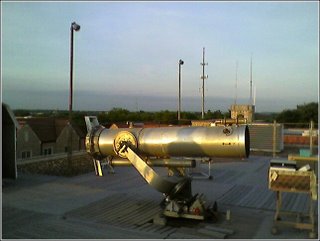
The main telescope, a 16" f/6 (or thereabouts) Newtonian reflector.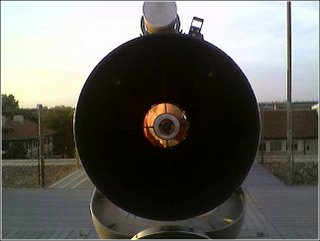
The blogger's occluded self-portrait in the primary mirror of the Warko 'scope.
Back end of the Warko 'scope, showing the 9-point flotation mirror cell.
Dusk, looking north toward downtown KC MO.
A fine Missourian sunset from the roof of Royall Hall at UMKC.
Jay Manifold [8:45 AM]
Powell Observatory Photo Essay (I)
Powell Observatory is open to the public every Saturday night from May through October; I am on one of the volunteer teams that cover these nights, and my first duty weekend was a couple of weeks ago. These are taken with a camera phone, so they're not the highest quality; I hope they will nonetheless convey a sense of the experience. Click on the images for full-size (640 × 480) versions.
The dome silhouetted at sunset.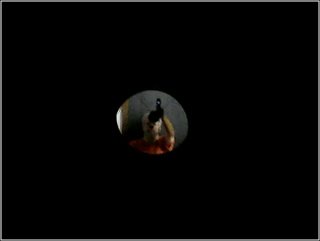
The blogger as reflected in the main mirror of the Ruisinger telescope, the largest in a 5-state area.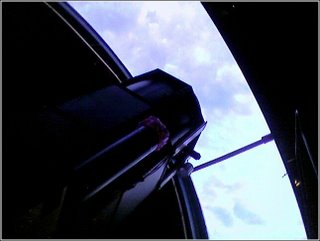
Inside the dome, the Ruisinger 30" telescope, already aimed at Saturn.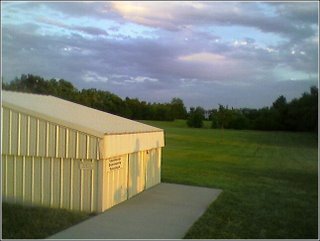
Also at Powell, the Louisburg Community Telescope (note shadows of amateur astronomers) ...
Louisburg Community Telescope(s), actually: 12.5" and 16" Meade Starfinder reflectors.
Jay Manifold [7:55 AM]
Powell Observatory Photo Essay (II)
Blogger limits posts to 5 pictures apiece. Continuing ... once again, you may click on these for larger versions.
The 16" has a bit of extra decoration. Unfortunately it also has a bad spider mount for the secondary mirror, and won't be seeing much use until that gets replaced.
A fine Kansas sunset from Powell Observatory.
For background on Powell, read Powell Observatory at 20 and follow the links.
Jay Manifold [7:50 AM]




